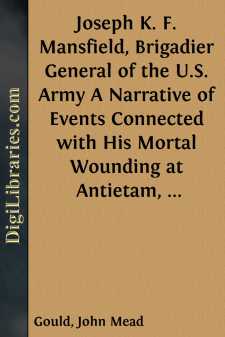Categories
- Antiques & Collectibles 13
- Architecture 36
- Art 48
- Bibles 22
- Biography & Autobiography 813
- Body, Mind & Spirit 142
- Business & Economics 28
- Children's Books 15
- Children's Fiction 12
- Computers 4
- Cooking 94
- Crafts & Hobbies 4
- Drama 346
- Education 46
- Family & Relationships 57
- Fiction 11829
- Games 19
- Gardening 17
- Health & Fitness 34
- History 1377
- House & Home 1
- Humor 147
- Juvenile Fiction 1873
- Juvenile Nonfiction 202
- Language Arts & Disciplines 88
- Law 16
- Literary Collections 686
- Literary Criticism 179
- Mathematics 13
- Medical 41
- Music 40
- Nature 179
- Non-Classifiable 1768
- Performing Arts 7
- Periodicals 1453
- Philosophy 64
- Photography 2
- Poetry 896
- Political Science 203
- Psychology 42
- Reference 154
- Religion 513
- Science 126
- Self-Help 84
- Social Science 81
- Sports & Recreation 34
- Study Aids 3
- Technology & Engineering 59
- Transportation 23
- Travel 463
- True Crime 29
Joseph K. F. Mansfield, Brigadier General of the U.S. Army A Narrative of Events Connected with His Mortal Wounding at Antietam, Sharpsburg, Maryland, September 17, 1862
by: John Mead Gould
Categories:
Description:
Excerpt
NARRATIVE.
It was bad enough and sad enough that Gen. Mansfield should be mortally wounded once, but to be wounded six, seven or eight times in as many localities is too much of a story to let stand unchallenged.
These pages will tell what the members of the 10th Maine Regiment know of the event, but first we will state what others have claimed.
The following places have been pointed out as the spot where Mansfield was wounded and all sorts of particulars have been given. Besides these a man with a magic-lantern is traveling through the country showing Burnside’s bridge, and remarking, “Here Mansfield fell.”
The spot marked A on the map is said to have been vouched for by a “New York officer of Mansfield’s staff.”
B is where the late David R. Miller understood the General was wounded by a sharpshooter stationed in Miller’s barn, west of the pike.
C is where Capt. Gardiner and Lieut. Dunegan, of Co. K, 125th Penn. Vols., assured me
that the General fell from his horse in front of their company.D is where, in November, 1894, I found a marker, that had been placed there the October previous, by some one unknown to me. These are the four principal places which have been pointed out to visitors. Still another spot was shown to our party when the 1-10-29th Maine Regiment Association made its first visit to the field, Oct. 4, 1889; it is south of A, but I did not note exactly where.
E. There has also been published in the National Tribune, which has an immense circulation among the soldiers, the statement of Col. John H. Keatley, now Commandant of the Soldier’s Home, Marshall-town, Iowa, who locates the place near the Dunker Church.
Col. Keatley’s letters show that he has been on the field several times since the war, which makes it harder to believe what would seem very plain otherwise, that his memory of locations has failed him. He appears to have got the recollection of the two woods mixed. Keatley was Sergeant of Co. A, the extreme left of the 125th Penn.
Mr. Alexander Davis, who resided and worked on the field before and after the battle, points out a place several rods northeast of the present residence of Millard F. Nicodemus (built since the war and not shown on the map). Some Indiana troops were the supposed original authority for this place, which is not far from B. It is only fair to Mr. Davis to add that he claims no personal knowledge.
There are several other places that have been described to me in private letters, but these need no mention here.
WHY SO MANY ERRORS?
Why has there been so much difficulty in identifying the right locality?
There has been no difficulty, none whatever, among those who knew the facts. The errors have all come from the ignorant, the imaginative, and those who have poor memories.
It will be easy, especially for one standing on the ground while reading these pages, to see that very few except the 10th Maine would witness the event, as we were so nearly isolated and almost hidden. We made very little account at the time, of what is now considered an important event in the history of the battle....



